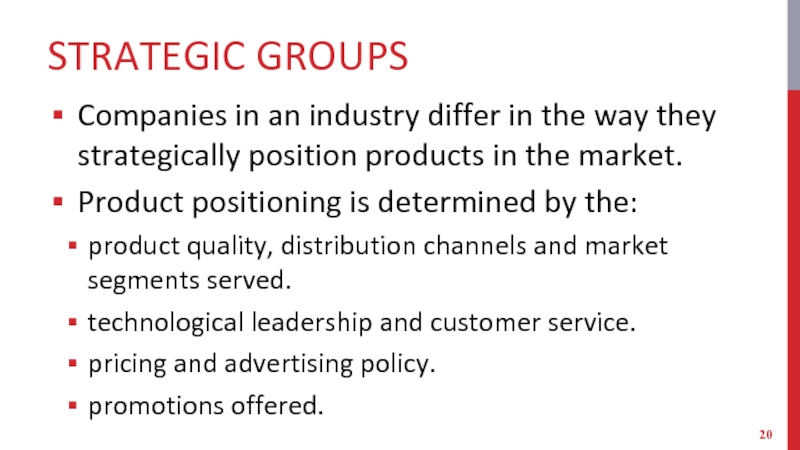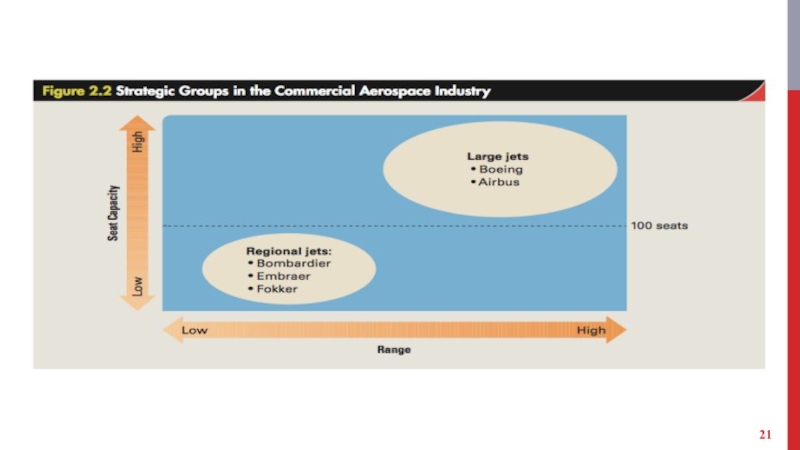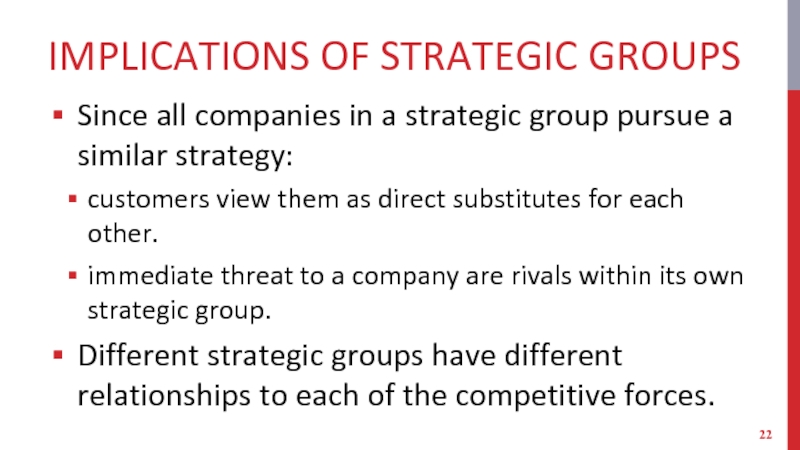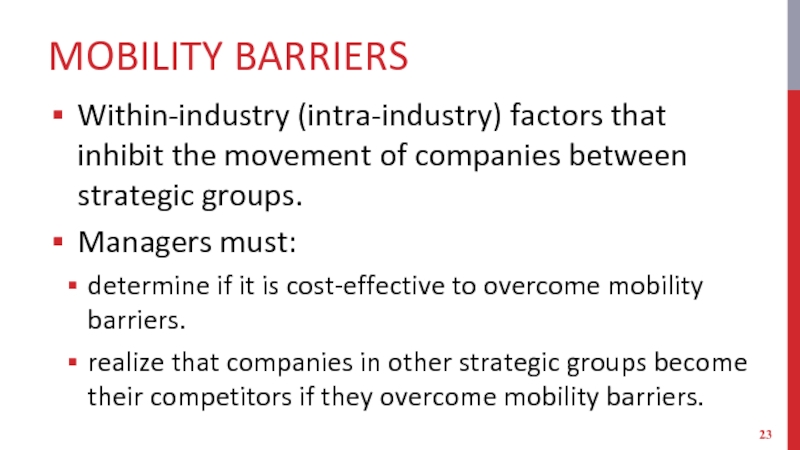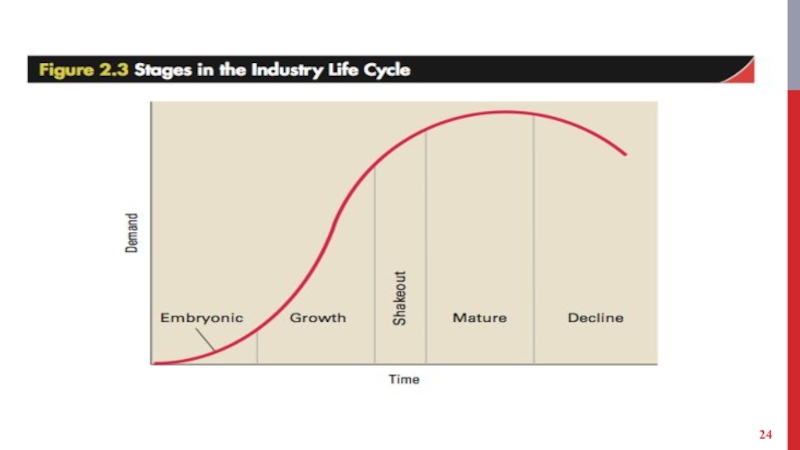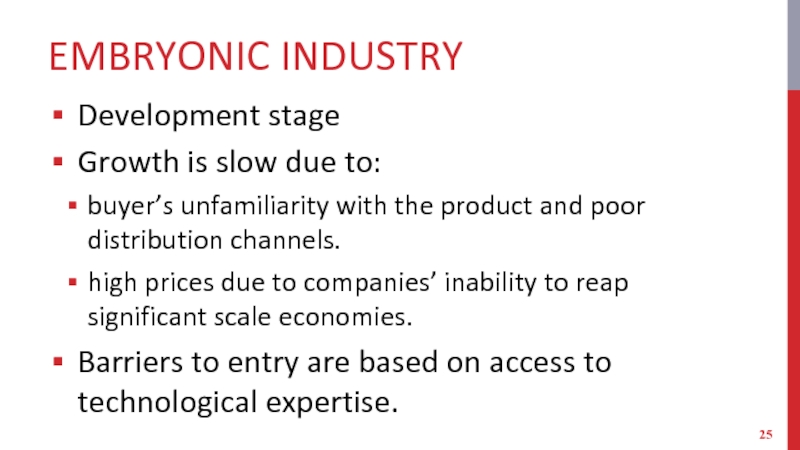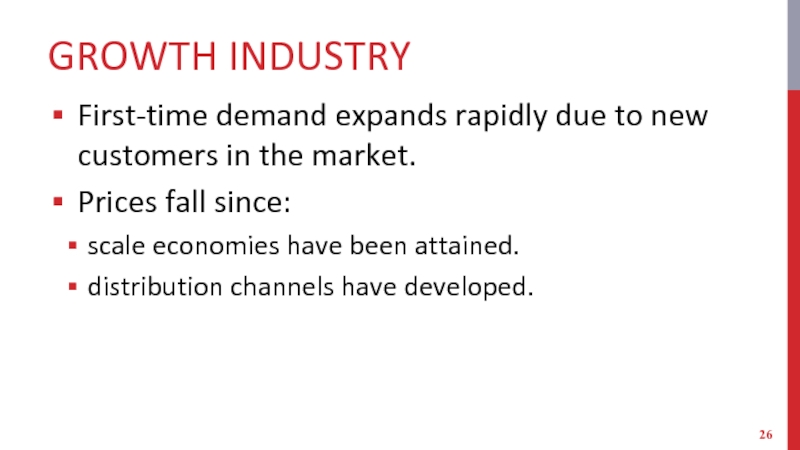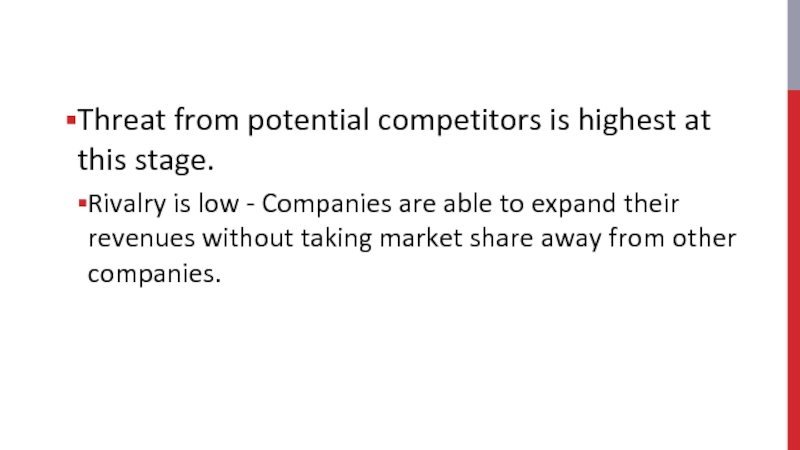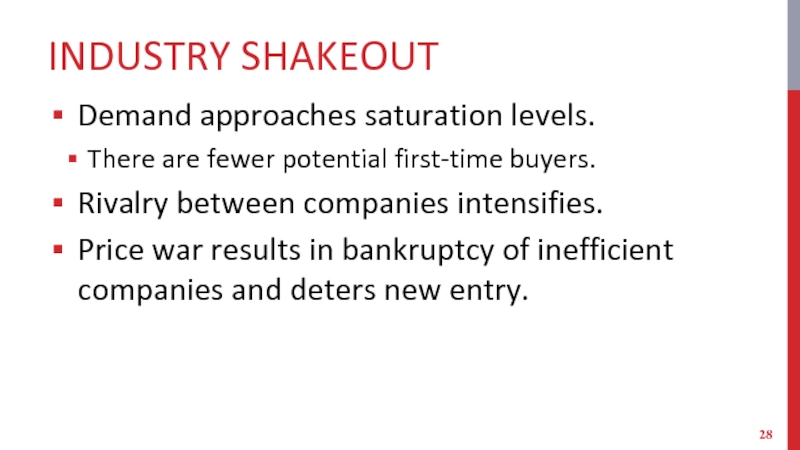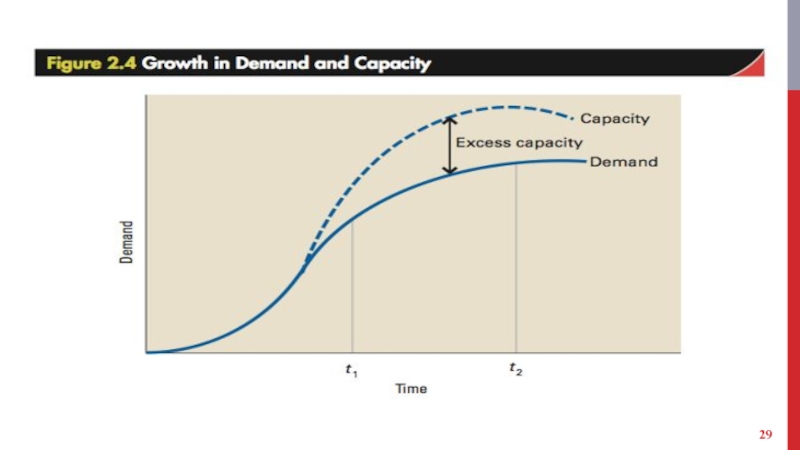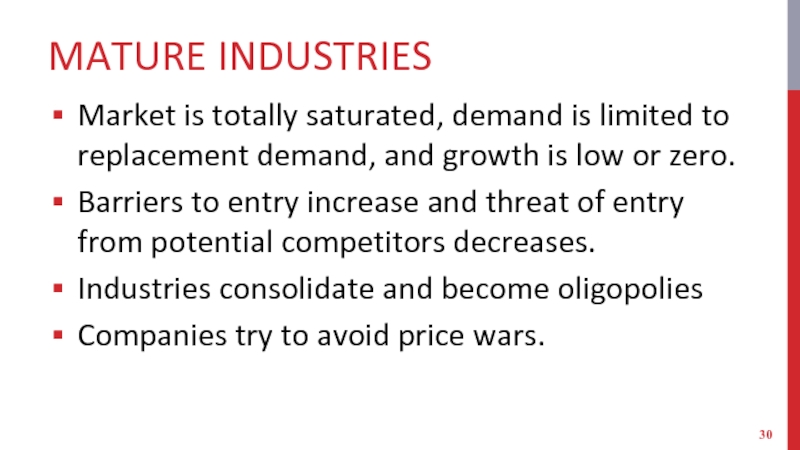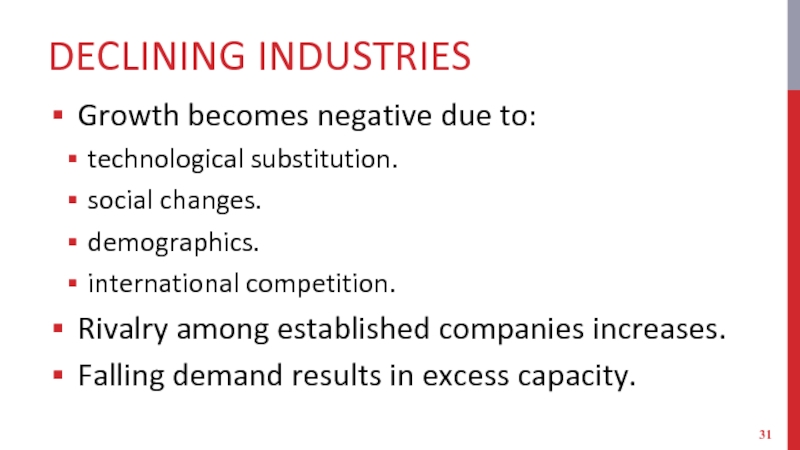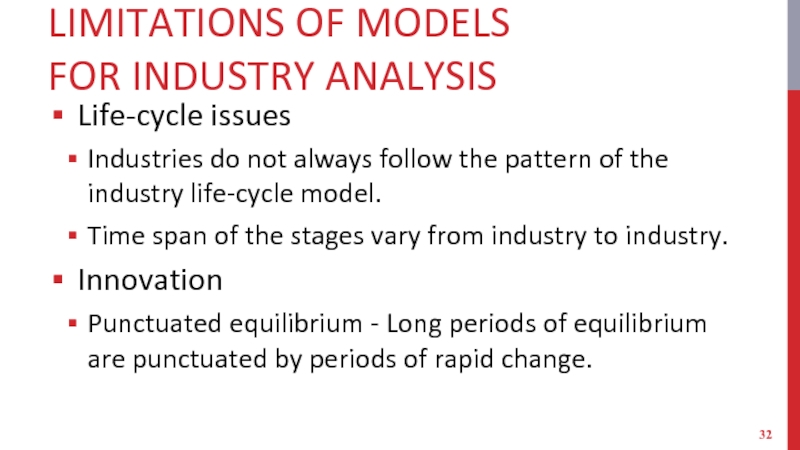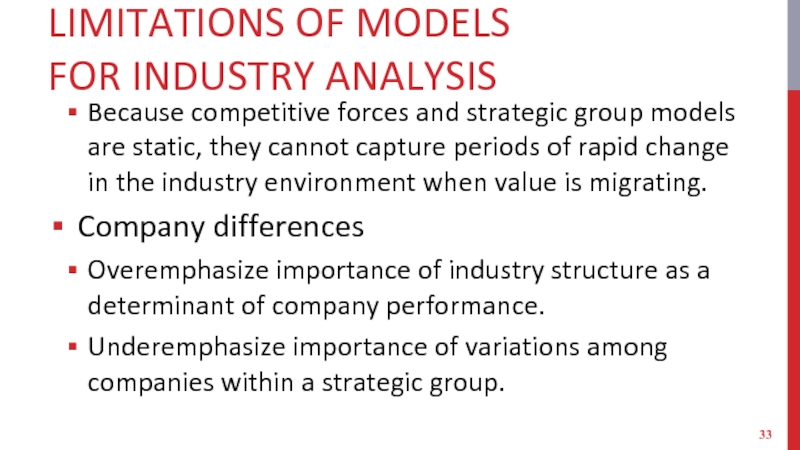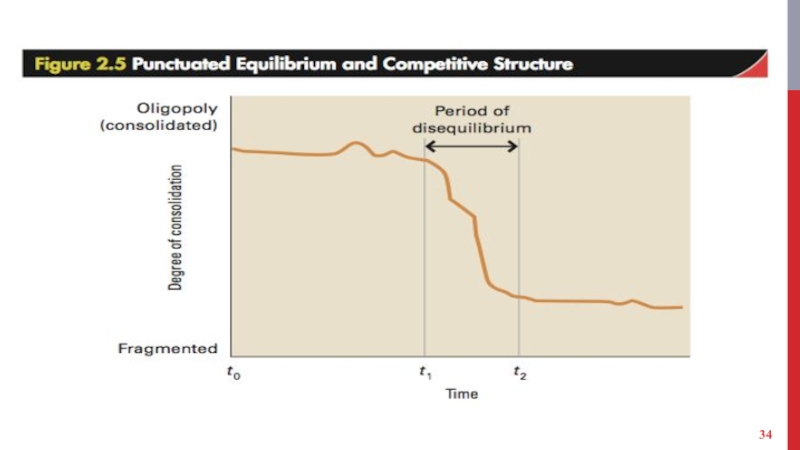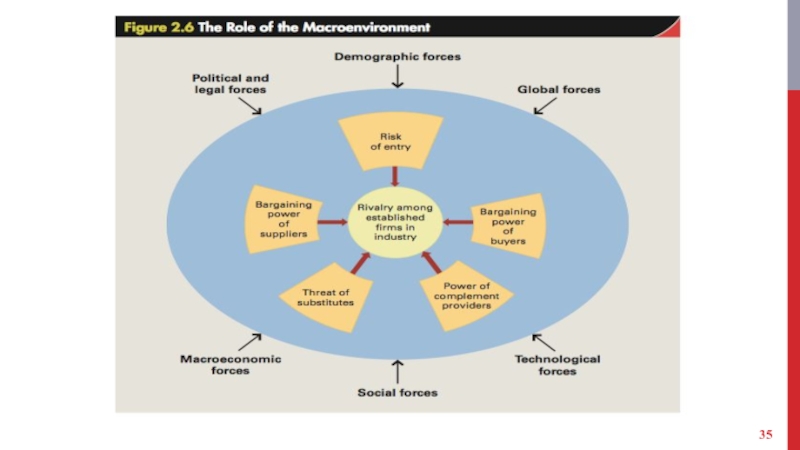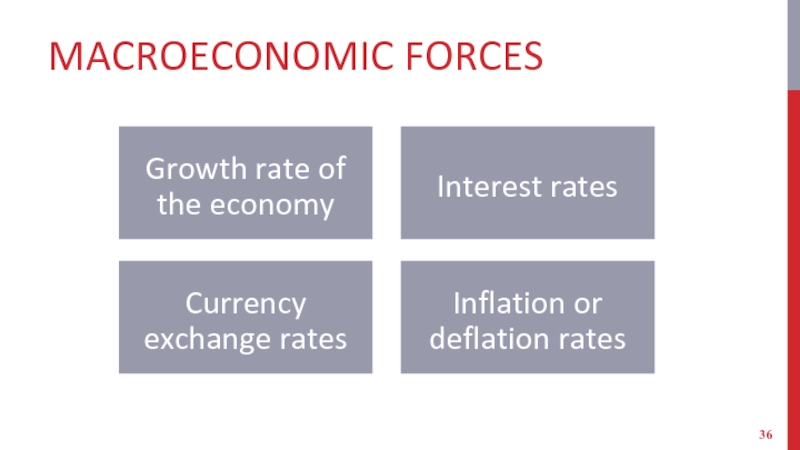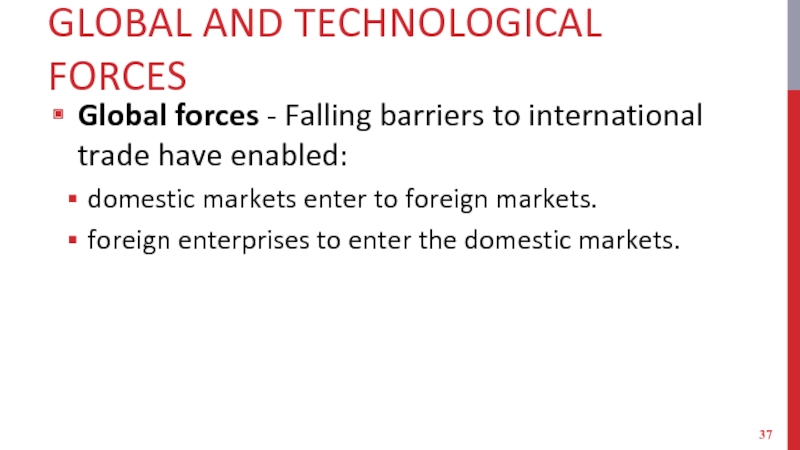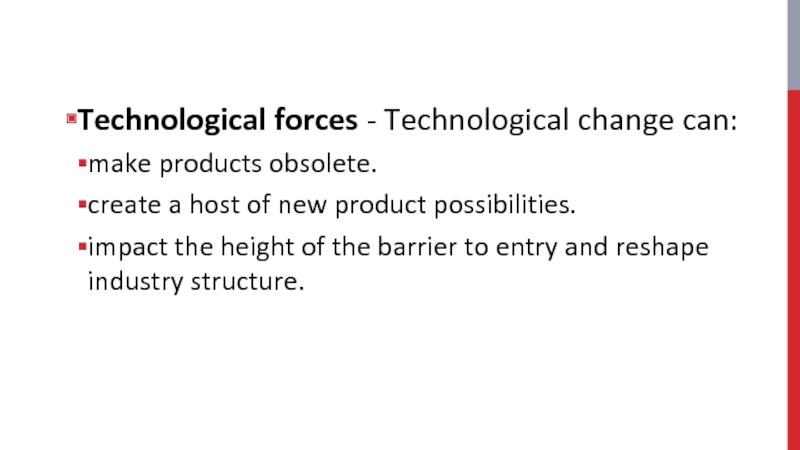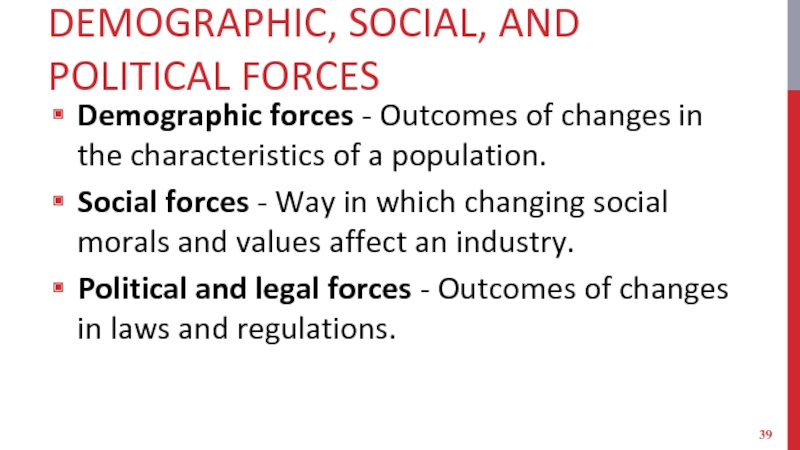- Главная
- Разное
- Дизайн
- Бизнес и предпринимательство
- Аналитика
- Образование
- Развлечения
- Красота и здоровье
- Финансы
- Государство
- Путешествия
- Спорт
- Недвижимость
- Армия
- Графика
- Культурология
- Еда и кулинария
- Лингвистика
- Английский язык
- Астрономия
- Алгебра
- Биология
- География
- Детские презентации
- Информатика
- История
- Литература
- Маркетинг
- Математика
- Медицина
- Менеджмент
- Музыка
- МХК
- Немецкий язык
- ОБЖ
- Обществознание
- Окружающий мир
- Педагогика
- Русский язык
- Технология
- Физика
- Философия
- Химия
- Шаблоны, картинки для презентаций
- Экология
- Экономика
- Юриспруденция
HSJ Chapter 2. Opportunities and threats презентация
Содержание
- 1. HSJ Chapter 2. Opportunities and threats
- 2. OPPORTUNITIES AND THREATS Opportunities: Elements in a
- 3. DEFINING AN INDUSTRY Industry: Group of companies
- 4. DEFINING THE INDUSTRY Coca-Cola Apple Uber
- 6. BARRIERS TO ENTRY Economies of Scale Enjoyed
- 7. MORE BARRIERS Customer Switching Costs Costs
- 8. RIVALRY AMONG ESTABLISHED COMPANIES Competitive struggle between
- 9. RIVALRY AMONG ESTABLISHED COMPANIES Demand conditions -
- 10. Exit barriers - Economic, strategic, and
- 12. BARGAINING POWER OF BUYERS Bargain down
- 13. With low switching costs and ability
- 14. BARGAINING POWER OF SUPPLIERS Suppliers’ ability to
- 15. Threat of entering customers’ industry. Knowledge that companies cannot enter the suppliers’ industry.
- 17. Substitute products - Those of different
- 19. Complementors - [@Intel’s Andy Grove] Companies
- 20. STRATEGIC GROUPS Companies in an industry differ
- 22. IMPLICATIONS OF STRATEGIC GROUPS Since all companies
- 23. MOBILITY BARRIERS Within-industry (intra-industry) factors that inhibit
- 25. EMBRYONIC INDUSTRY Development stage Growth is slow
- 26. GROWTH INDUSTRY First-time demand expands rapidly due
- 27. Threat from potential competitors is highest
- 28. INDUSTRY SHAKEOUT Demand approaches saturation levels. There
- 30. MATURE INDUSTRIES Market is totally saturated, demand
- 31. DECLINING INDUSTRIES Growth becomes negative due to:
- 32. LIMITATIONS OF MODELS FOR INDUSTRY ANALYSIS Life-cycle
- 33. LIMITATIONS OF MODELS FOR INDUSTRY ANALYSIS Because
- 36. MACROECONOMIC FORCES Growth rate of the economy
- 37. GLOBAL AND TECHNOLOGICAL FORCES Global forces -
- 38. Technological forces - Technological change can:
- 39. DEMOGRAPHIC, SOCIAL, AND POLITICAL FORCES Demographic forces
Слайд 2OPPORTUNITIES AND THREATS
Opportunities: Elements in a company’s environment that allow it
to formulate and implement strategies to become more profitable.
Threats: Elements in the external environment that could endanger a firm’s integrity and profitability.
Threats: Elements in the external environment that could endanger a firm’s integrity and profitability.
Слайд 3DEFINING AN INDUSTRY
Industry: Group of companies offering products or services that
are close substitutes for each other.
Sector: Group of closely related industries.
Sector: Group of closely related industries.
Слайд 6BARRIERS TO ENTRY
Economies of Scale
Enjoyed by incumbents in an industry and
that new entrants cannot expect to match.
Brand Loyalty
Preference of consumers for the products of established companies.
Absolute Cost Advantages
Brand Loyalty
Preference of consumers for the products of established companies.
Absolute Cost Advantages
Слайд 7MORE BARRIERS
Customer Switching Costs
Costs that consumers must bear to switch from
the products offered by one established company to the products offered by a new entrant.
Government Regulations
Falling entry barriers due to government regulation results in significant new entry, increase in the intensity of industry competition, and lower industry profit rates.
Government Regulations
Falling entry barriers due to government regulation results in significant new entry, increase in the intensity of industry competition, and lower industry profit rates.
Слайд 8RIVALRY AMONG ESTABLISHED COMPANIES
Competitive struggle between companies within an industry to
gain market share from each other.
Intense rivalry among established companies constitutes a strong threat to profitability.
Factors that impact the intensity of rivalry among established companies within an industry.
Industry competitive structure - number and size distribution of companies in it.
Intense rivalry among established companies constitutes a strong threat to profitability.
Factors that impact the intensity of rivalry among established companies within an industry.
Industry competitive structure - number and size distribution of companies in it.
Слайд 9RIVALRY AMONG ESTABLISHED COMPANIES
Demand conditions - Increasing demand moderates competition by
providing greater scope for companies to compete for customers.
Cost conditions - When fixed costs are high, profitability is highly leveraged to sales volume.
Cost conditions - When fixed costs are high, profitability is highly leveraged to sales volume.
Слайд 10
Exit barriers - Economic, strategic, and emotional factors that prevent companies
from leaving an industry.
High exit barriers - Companies become locked into an unprofitable industry where overall demand is static or declining.
High exit barriers - Companies become locked into an unprofitable industry where overall demand is static or declining.
Слайд 12BARGAINING POWER OF BUYERS
Bargain down prices or raise costs by
demanding better product quality and service.
Choose sellers and purchase in large quantities.
Supplier industry is dependent on them for a major portion of sales.
Choose sellers and purchase in large quantities.
Supplier industry is dependent on them for a major portion of sales.
Слайд 13
With low switching costs and ability to purchase an input from
several companies at once, buyers can pit companies against each other.
Threat of entering the industry and producing the product.
Threat of entering the industry and producing the product.
Слайд 14BARGAINING POWER OF SUPPLIERS
Suppliers’ ability to raise input prices or industry
costs through various means.
Product has no substitutes and is vital to the buyer.
Not dependent on one particular industry for their sales.
Companies would incur high switching costs if they moved to a different supplier.
Product has no substitutes and is vital to the buyer.
Not dependent on one particular industry for their sales.
Companies would incur high switching costs if they moved to a different supplier.
Слайд 15
Threat of entering customers’ industry.
Knowledge that companies cannot enter the suppliers’
industry.
Слайд 17
Substitute products - Those of different businesses that satisfy similar customer
needs.
Limit the price that companies in an industry can charge for their product.
Limit the price that companies in an industry can charge for their product.
Слайд 19
Complementors - [@Intel’s Andy Grove] Companies that sell products that add
value to the other products.
Strong complementors - Provide a increased opportunity for creating value.
Weak complementors - Slow industry growth and limit profitability.
Strong complementors - Provide a increased opportunity for creating value.
Weak complementors - Slow industry growth and limit profitability.
Слайд 20STRATEGIC GROUPS
Companies in an industry differ in the way they strategically
position products in the market.
Product positioning is determined by the:
product quality, distribution channels and market segments served.
technological leadership and customer service.
pricing and advertising policy.
promotions offered.
Product positioning is determined by the:
product quality, distribution channels and market segments served.
technological leadership and customer service.
pricing and advertising policy.
promotions offered.
Слайд 22IMPLICATIONS OF STRATEGIC GROUPS
Since all companies in a strategic group pursue
a similar strategy:
customers view them as direct substitutes for each other.
immediate threat to a company are rivals within its own strategic group.
Different strategic groups have different relationships to each of the competitive forces.
customers view them as direct substitutes for each other.
immediate threat to a company are rivals within its own strategic group.
Different strategic groups have different relationships to each of the competitive forces.
Слайд 23MOBILITY BARRIERS
Within-industry (intra-industry) factors that inhibit the movement of companies between
strategic groups.
Managers must:
determine if it is cost-effective to overcome mobility barriers.
realize that companies in other strategic groups become their competitors if they overcome mobility barriers.
Managers must:
determine if it is cost-effective to overcome mobility barriers.
realize that companies in other strategic groups become their competitors if they overcome mobility barriers.
Слайд 25EMBRYONIC INDUSTRY
Development stage
Growth is slow due to:
buyer’s unfamiliarity with the product
and poor distribution channels.
high prices due to companies’ inability to reap significant scale economies.
Barriers to entry are based on access to technological expertise.
high prices due to companies’ inability to reap significant scale economies.
Barriers to entry are based on access to technological expertise.
Слайд 26GROWTH INDUSTRY
First-time demand expands rapidly due to new customers in the
market.
Prices fall since:
scale economies have been attained.
distribution channels have developed.
Prices fall since:
scale economies have been attained.
distribution channels have developed.
Слайд 27
Threat from potential competitors is highest at this stage.
Rivalry is low
- Companies are able to expand their revenues without taking market share away from other companies.
Слайд 28INDUSTRY SHAKEOUT
Demand approaches saturation levels.
There are fewer potential first-time buyers.
Rivalry between
companies intensifies.
Price war results in bankruptcy of inefficient companies and deters new entry.
Price war results in bankruptcy of inefficient companies and deters new entry.
Слайд 30MATURE INDUSTRIES
Market is totally saturated, demand is limited to replacement demand,
and growth is low or zero.
Barriers to entry increase and threat of entry from potential competitors decreases.
Industries consolidate and become oligopolies
Companies try to avoid price wars.
Barriers to entry increase and threat of entry from potential competitors decreases.
Industries consolidate and become oligopolies
Companies try to avoid price wars.
Слайд 31DECLINING INDUSTRIES
Growth becomes negative due to:
technological substitution.
social changes.
demographics.
international competition.
Rivalry among established
companies increases.
Falling demand results in excess capacity.
Falling demand results in excess capacity.
Слайд 32LIMITATIONS OF MODELS
FOR INDUSTRY ANALYSIS
Life-cycle issues
Industries do not always follow the
pattern of the industry life-cycle model.
Time span of the stages vary from industry to industry.
Innovation
Punctuated equilibrium - Long periods of equilibrium are punctuated by periods of rapid change.
Time span of the stages vary from industry to industry.
Innovation
Punctuated equilibrium - Long periods of equilibrium are punctuated by periods of rapid change.
Слайд 33LIMITATIONS OF MODELS
FOR INDUSTRY ANALYSIS
Because competitive forces and strategic group models
are static, they cannot capture periods of rapid change in the industry environment when value is migrating.
Company differences
Overemphasize importance of industry structure as a determinant of company performance.
Underemphasize importance of variations among companies within a strategic group.
Company differences
Overemphasize importance of industry structure as a determinant of company performance.
Underemphasize importance of variations among companies within a strategic group.
Слайд 36MACROECONOMIC FORCES
Growth rate of the economy
Interest rates
Currency exchange rates
Inflation or deflation
rates
Слайд 37GLOBAL AND TECHNOLOGICAL FORCES
Global forces - Falling barriers to international trade
have enabled:
domestic markets enter to foreign markets.
foreign enterprises to enter the domestic markets.
domestic markets enter to foreign markets.
foreign enterprises to enter the domestic markets.
Слайд 38
Technological forces - Technological change can:
make products obsolete.
create a host of
new product possibilities.
impact the height of the barrier to entry and reshape industry structure.
impact the height of the barrier to entry and reshape industry structure.
Слайд 39DEMOGRAPHIC, SOCIAL, AND POLITICAL FORCES
Demographic forces - Outcomes of changes in
the characteristics of a population.
Social forces - Way in which changing social morals and values affect an industry.
Political and legal forces - Outcomes of changes in laws and regulations.
Social forces - Way in which changing social morals and values affect an industry.
Political and legal forces - Outcomes of changes in laws and regulations.

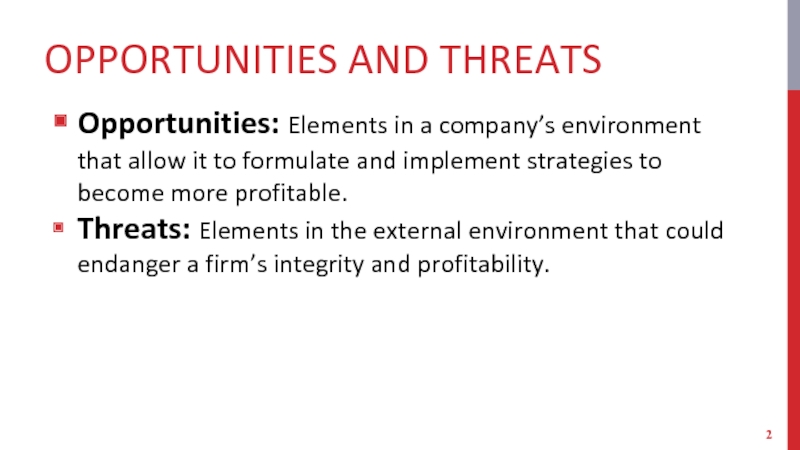
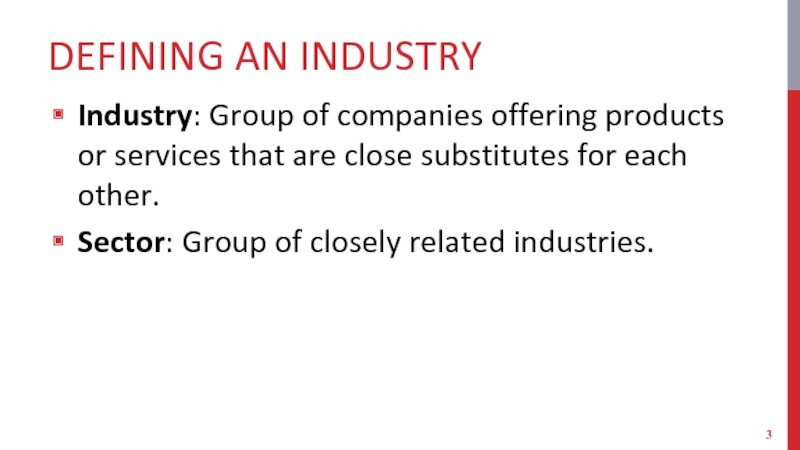
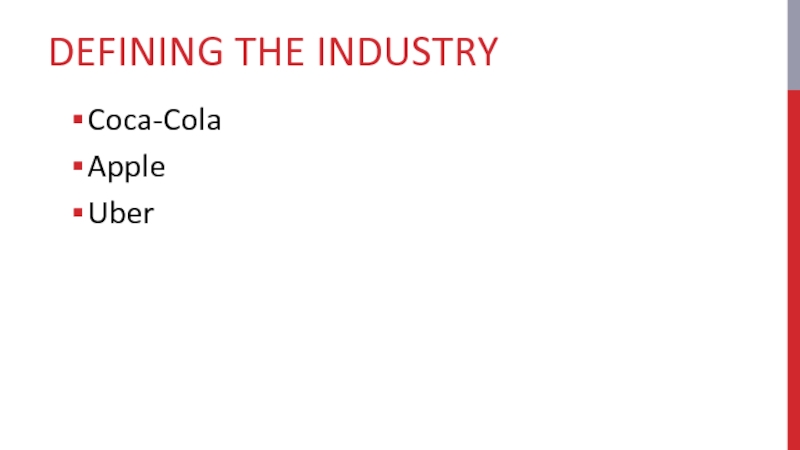
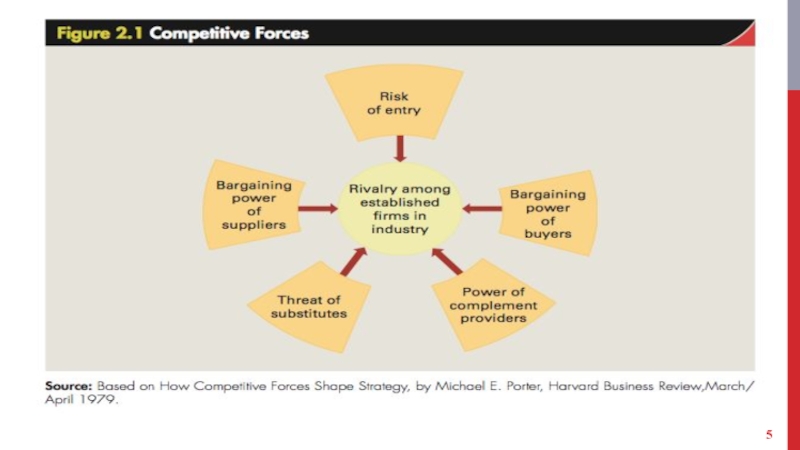
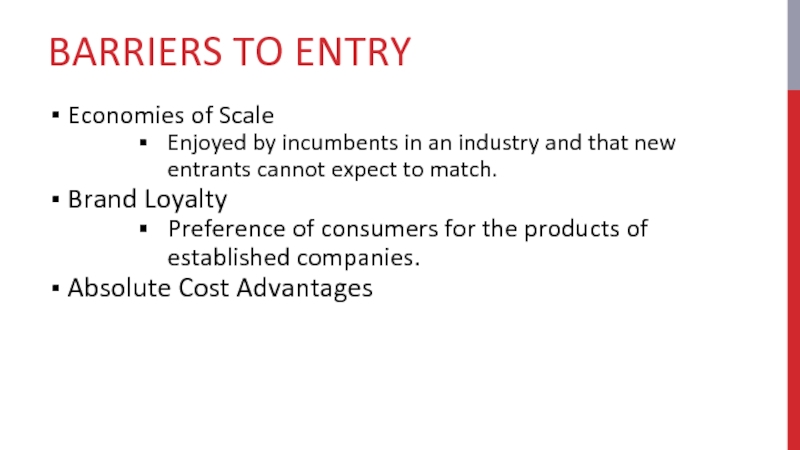
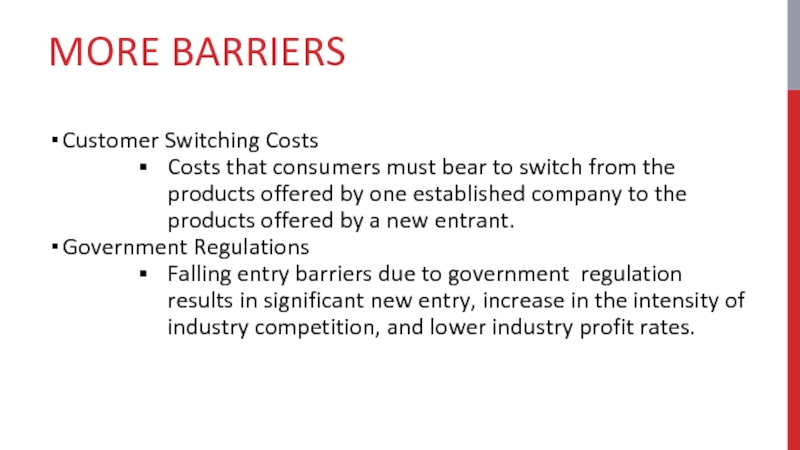
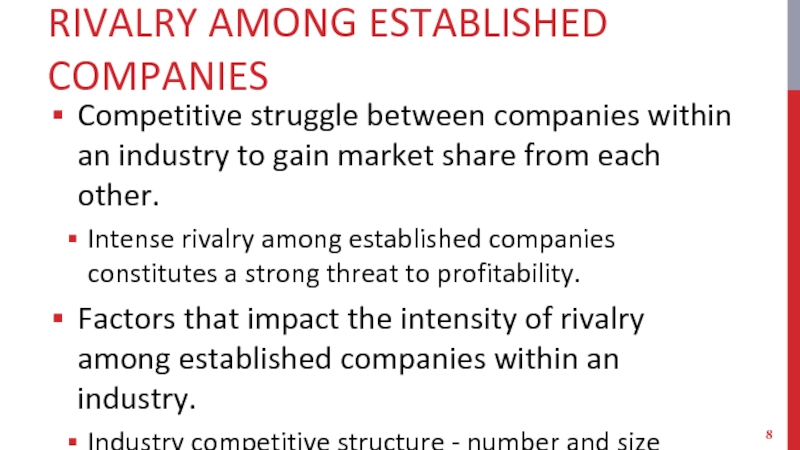
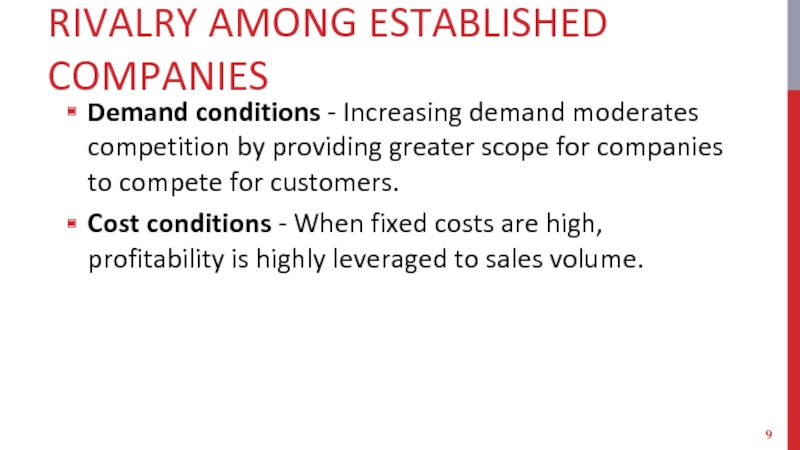
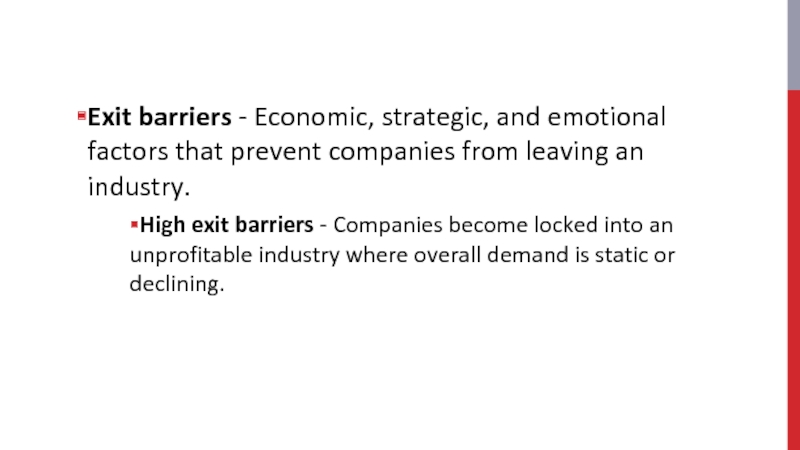
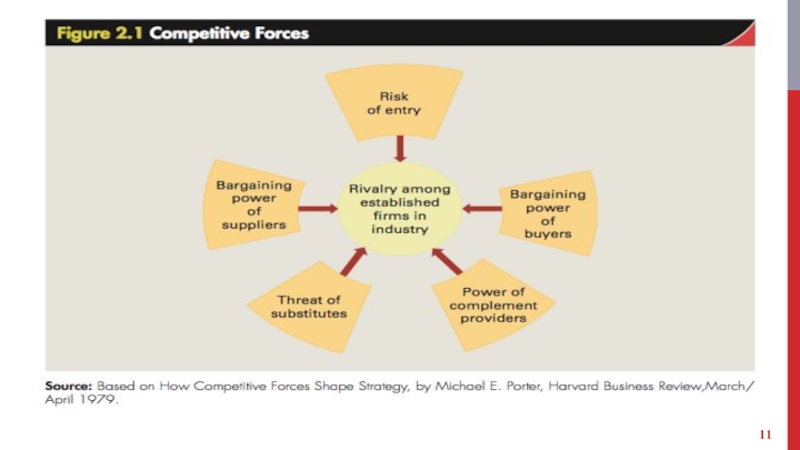
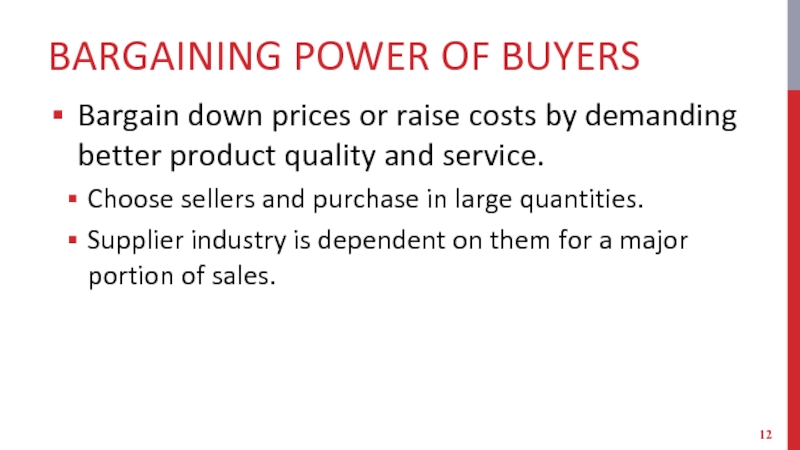
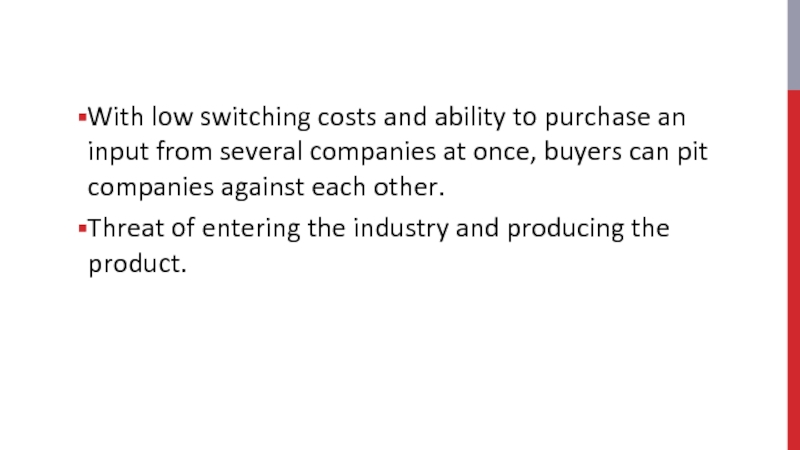
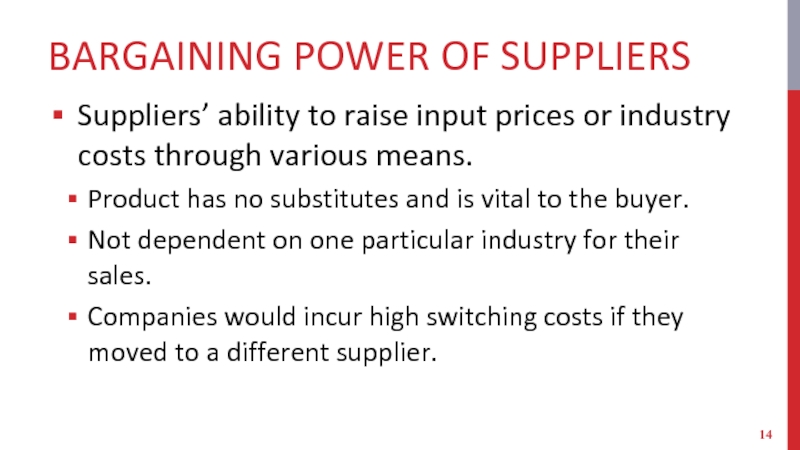
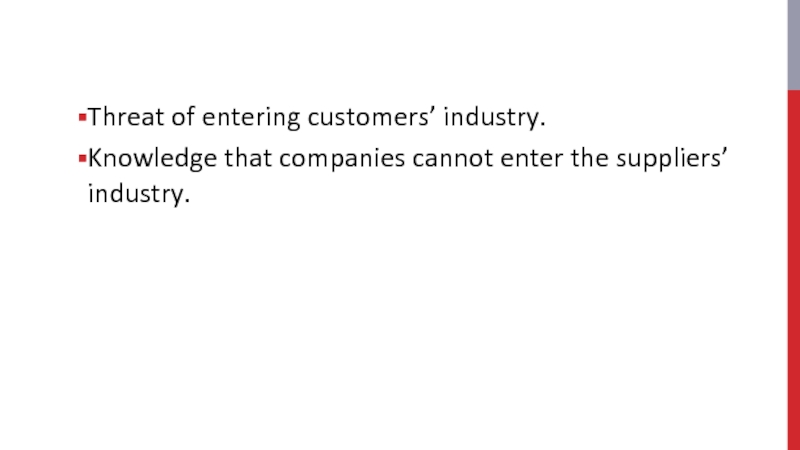
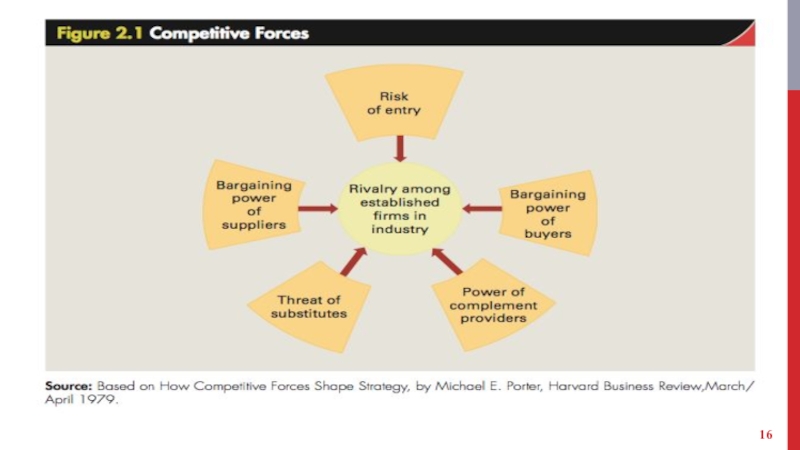
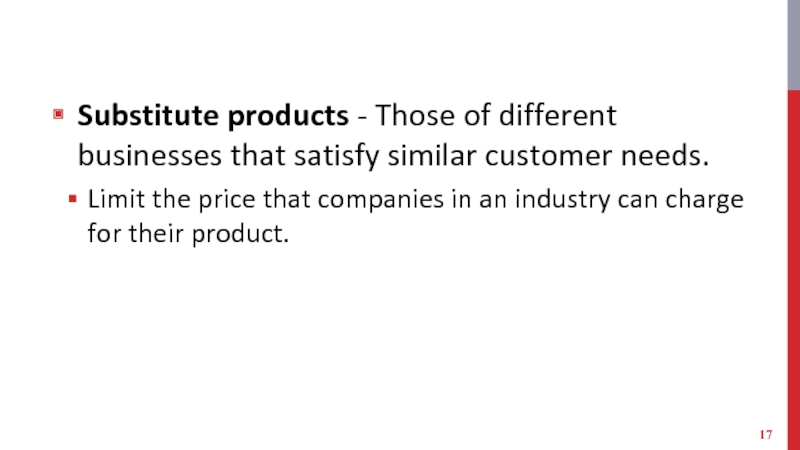
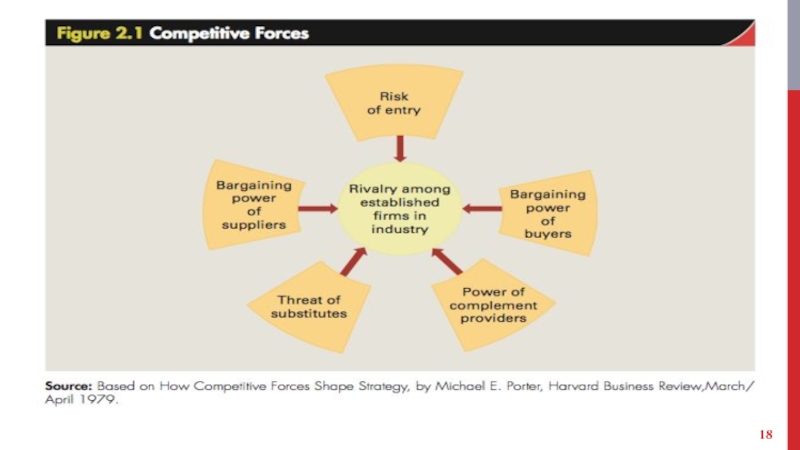
![Complementors - [@Intel’s Andy Grove] Companies that sell products that add value to the other](/img/tmb/2/175323/bd15ceb1d120e52132677252557bc3c8-800x.jpg)
